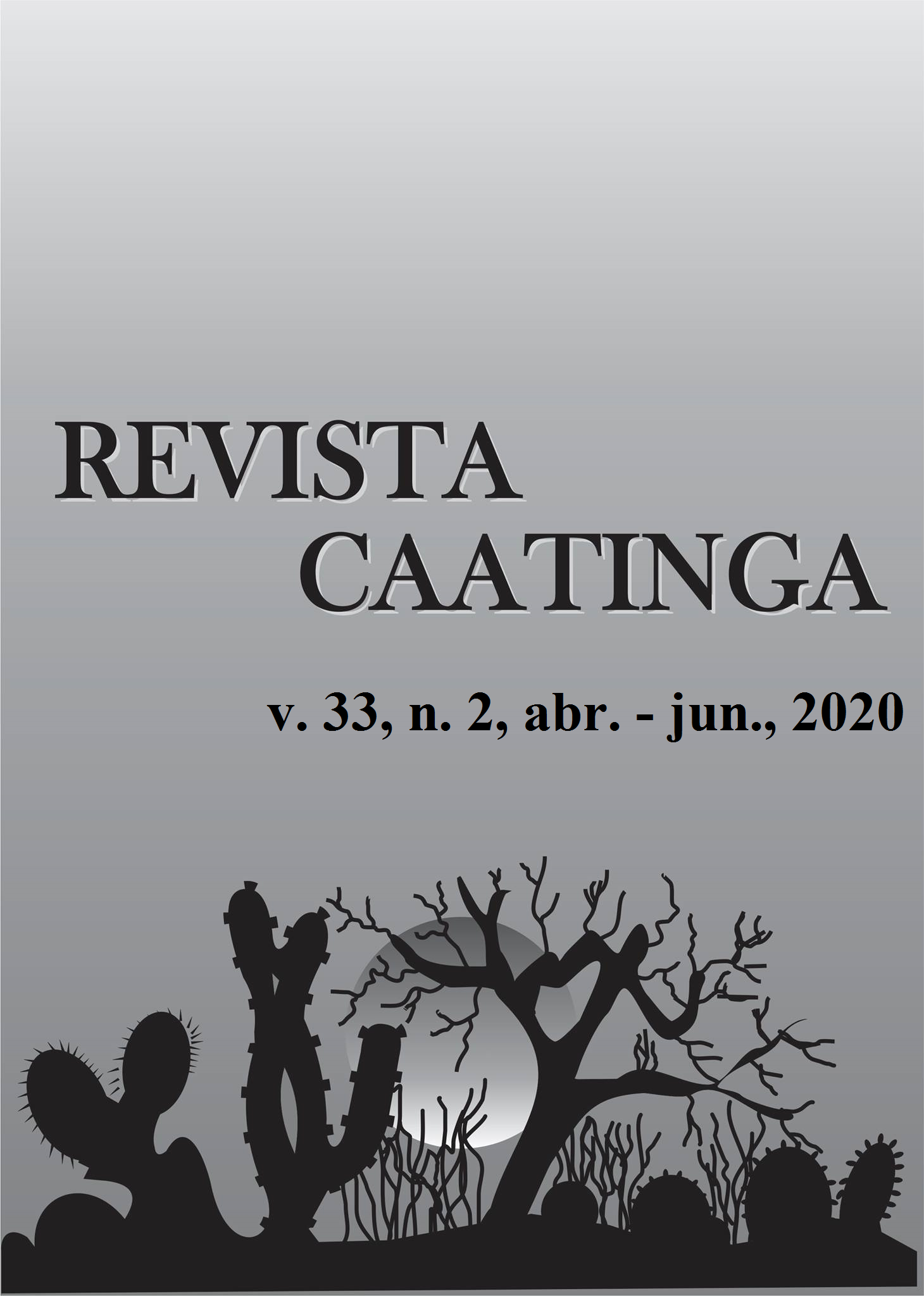SPATIAL VARIABILITY OF SOIL RESISTANCE MECHANICS TO PENETRATION UNDER DIFFERENT CONDITIONS OF SUGAR CANE HARVEST
DOI:
https://doi.org/10.1590/1983-21252020v33n220rcKeywords:
Soil compaction. Controlled traffic. Geostatistics.Abstract
The objective of this work was to evaluate the spatial variability of resistance to penetration in soil under sugarcane crops subjected to different harvest methods in the North Coast microregion of the state of Paraiba, Brazil. The study was conducted in a Typic Hapludult under sugarcane crops, at the farms Santa Emília-II and Maria da Luz-I of the company Miriri Food and Bioenergy S/A, in the municipalities of Rio Tinto and Capim, respectively, state of Paraíba, Brazil. Three sugarcane areas with different harvest methods (manual, mechanized, and manual/mechanized) were selected. The sampling was done in plots of 100 × 100 m, using a grid of 20 × 20 m, covering planting rows and interrows; each intersection point of the grid was georeferenced, and the soil mechanic resistance to penetration was evaluated with the aid of an impact penetrometer (IAA/Planalsucar-Stolf) up to the depth of 0-0.6 m. Soil disturbed and undisturbed samples from the 0.0-0.1 and 0.1-0.2 m layers were collected for analyses of soil moisture, texture, clay dispersed in water, flocculation degree. A pure nugget effect was found in the 0.0-0.1 and 0.4-0.5 m soil layers in the rows of the areas with manual/mechanized harvest. The spherical model was found for most conditions evaluated. The results for the areas were similar, with amplitude of 25-49 m, indicating that the harvest management had no effect on the soil resistance to penetration. No compacted areas were found, and the spatial dependency of the resistance to penetration was characterized as moderate to strong.
Downloads
References
BRAUNACK, M. V. et al. Effect of harvest traffic position on soil conditions and sugarcane (Saccharum officinarum) response to environmental conditions in Queensland, Australia. Soil and Tillage Research, 89: 103-121, 2006.
CANCIAN, L. C. Variabilidade espacial da resistência a penetração, granulometria e umidade do solo. 2015. 59 f. Dissertação (Mestrado em Agronomia: Área de concentração em Ciência do Solo), Universidade Federal de Santa Maria, FredericoWestphalen, 2015.
CARVALHO FILHO, A. et al. Compactação do solo em cafeicultura irrigada. Uberaba, MG: UNIUBE, 2004. 44 p.
CASTRO, A. N. C. et al. Avaliação de atributos físicos do solo em diferentes anos de cultivo de cana-de-açúcar. Revista Agrarian, 6: 415-422. 2013.
CAVALIERI, K. M. V. et al. Qualidade física de três solos sob colheita mecanizada de cana-de-açúcar. Revista Brasileira de Ciência do Solo, 35: 1541-1550, 2011.
COELHO, D. S. et al. Variabilidade espacial da resistência mecânica à penetração em Vertissolo cultivado com manga no perímetro irrigado de Mandacaru, Juazeiro, Bahia, Brasil. Revista Brasileira de Ciência do Solo, 36: 755-764, 2012.
COMPANHIA NACIONAL DE ABASTECIMENTO - CONAB. Acompanhamento da Safra Brasileira de Cana-de-Açúcar: quarto levantamento. safra 2017/2018. Brasília: CONAB. 2017. 62 p. Disponível em: <http://www.conab.gov.br/OlalaCMS/uploads/arquivos/17_04_20_14_04_31_boletim_cana_portugues_-_1o_lev_-_17-18.pdf>. Acesso em: 30 maio 2017.
CRESSIE, N. A. C. Statistics for spatial data. New York, NY: John Wiley, 1991. 900 p.
DALCHIAVON, F. C; CARVALHO, M. P. Correlação linear e espacial dos componentes de produção e produtividade da soja. Semina: Ciências Agrárias, 33: 541-552, 2012.
FAO. FAOSTATS. Agricultura - Divisão de Estatísticas da FAO. 2014. Disponível em: <http://faostat.fao.org/site/339/default.aspx>. Acesso em: 20 abr. 2017.
GEE, G. W.; BAUDER, J. W. Particle-size analysis. In: KLUTE, A. Methods of soil analysis. American Society of Agronomy, 1: 383-411, 1986.
INSTITUTO BRASILEIRO DE GEOGRAFIA E ESTATÍSTICA - IBGE. Malha Municipal: Municípios da Paraíba. 2013. Disponível em: <http://downloads.ibge.gov.br/downloads_geociencias.htm>. Acesso em: 30 jul. 2017.
LIMA, R. P. et al. Compactação do solo de diferentes classes texturais em áreas de produção de cana-de-açúcar. Revista Ceres, 60: 16-20, 2013.
MION, R. L. et al. Variabilidade espacial da porosidade total, umidade e resistência do solo à penetração de um Argissolo Amarelo. Semina: Ciência Agrárias, 33: 2057-2066, 2012.
OLIVEIRA, I. A. et al. Variabilidade espacial de atributos físicos em um Cambissolo Háplico, sob diferentes usos na região Sul do Amazonas. Revista Brasileira de Ciência do Solo, 37: 1103-1112, 2013.
OTTO, R. et al. High soil penetration resistance reduces sugarcane root system development. Soil and Tillage Research, 117: 201-210, 2011.
SANTOS, H. G. et al. Sistema Brasileiro de Classificação de Solos. 5. ed. Brasília, DF: Embrapa. 2018. 356 p.
SILVA, A. J. N.; CABEDA, M. S. V. Compactação e compressibilidade do solo sob sistemas de manejo e níveis de umidade. Revista Brasileira de Ciência do Solo, 30: 921-930, 2006.
SOUZA, Z. M. et al. Spatial variability of the physical and mineralogical properties of the soil from the areas with variation in landscape shapes. Brazilian Archives of Biology and Technology, 52: 305-316, 2009.
TEIXEIRA, P. C. et al. Manual de métodos de análise de solos. 3.ed. Rio de Janeiro, RJ: Embrapa Solos. 2017. 573 p.
WARRICK, A. W.; NIELSEN, D. R. Spatial variability of soil physical properties in the field. In: HILLEL, D. (Ed.). Applications of Soil Physics. New York, NY: Academic Press, 1980. v. 1, cap. 2, p. 319-344.
Downloads
Published
Issue
Section
License
Os Autores que publicam na Revista Caatinga concordam com os seguintes termos:
a) Os Autores mantêm os direitos autorais e concedem à revista o direito de primeira publicação, com o trabalho simultaneamente licenciado sob a Licença Creative Commons do tipo atribuição CC-BY, para todo o conteúdo do periódico, exceto onde estiver identificado, que permite o compartilhamento do trabalho com reconhecimento da autoria e publicação inicial nesta revista, sem fins comerciais.
b) Os Autores têm autorização para distribuição não-exclusiva da versão do trabalho publicada nesta revista (ex.: publicar em repositório institucional ou como capítulo de livro), com reconhecimento de autoria e publicação inicial nesta revista.
c) Os Autores têm permissão e são estimulados a publicar e distribuir seu trabalho online (ex.: em repositórios institucionais ou na sua página pessoal) a qualquer ponto antes ou durante o processo editorial, já que isso pode gerar alterações produtivas, bem como aumentar o impacto e a citação do trabalho publicado (Veja O Efeito do Acesso Livre).







